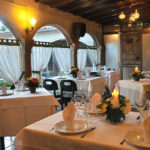8.30: Putting It Together: ¿Qué te gusta comer?
- Page ID
- 50259
Click on each link below for a review summary to help you complete the assignments and prepare for the quiz to demonstrate your mastery of the objectives.
[reveal-answer q=”316707″]Identify places in the community[/reveal-answer]
[hidden-answer a=”316707″]

[/hidden-answer]
[reveal-answer q=”570694″]Understand and use the irregular verb “ir” to talk about going to places[/reveal-answer]
[hidden-answer a=”570694″]
ir (to go)
| Singular | Plural |
Contractions
There are only two contractions in the whole Spanish language, and they’re frequently used with ir and other verbs of motion.
A + el = al (to the)
De + el = del (from the)
[/hidden-answer]
[reveal-answer q=”714888″]Use the infinitive after “ir” + “a” to talk about plans and future events[/reveal-answer]
[hidden-answer a=”714888″]
The verb ir is also used as a way to describe future plans when used in the following manner: ir + a + infinitive. It’s important to remember that you only need to conjugate ir in this kind of sentence. Another way of looking at it is the rule that after a preposition (like a), a verb will always be in the infinitive.
![]() Yo voy a estudiar esta noche. (I’m going to study tonight.)
Yo voy a estudiar esta noche. (I’m going to study tonight.)
![]() Tú no vas a ganar mucho dinero aquí. (You are not going to earn much money here.)
Tú no vas a ganar mucho dinero aquí. (You are not going to earn much money here.)
![]() ¿Va usted a comer conmigo? (Are you going to eat with me?)
¿Va usted a comer conmigo? (Are you going to eat with me?)
[/hidden-answer]
[reveal-answer q=”71965″]Identify vocabulary relating to foods, cooking and eating[/reveal-answer]
[hidden-answer a=”71965″]
 Comidas
Comidas
[/hidden-answer]
[reveal-answer q=”638795″]Use the correct pronouns and correct forms of “gustar” to say what things you and others like and don’t like[/reveal-answer]
[hidden-answer a=”638795″]
The Spanish equivalent of “I like” is me gusta, which literally means “it pleases me”. To indicate whether someone else likes something, you change the indirect object pronoun:
| singular | plural | |
| primera (1a) | ||
| segunda (2a) | ||
| tercera (3a) |
When you use the verb gustar, the form you choose will depend on whether what you like is a singular noun, a plural noun, or a verb.
The verb form gusta is always in the singular when the noun that is liked or disliked is singular, because *it* is pleasing to the person:
![]() (A mí) me gusta la casa. (I like the house. Literally: The house pleases me.)
(A mí) me gusta la casa. (I like the house. Literally: The house pleases me.)
What if plural things are pleasing to you? The verb form gustan is always in the plural when the noun is plural or there are two nouns, because they please the person:
![]() (A mí) me gustan las casas. (I like the houses. Literally: The houses please me.)
(A mí) me gustan las casas. (I like the houses. Literally: The houses please me.)
[/hidden-answer]
[reveal-answer q=”878793″]Understand and use o-ue, e-ie, and e-i stem-changing verbs[/reveal-answer]
[hidden-answer a=”878793″]
A. Verbos con cambio de raíz e>ie
| Singular | Plural | |
| 1a | ||
| 2a | ||
| 3a | ||
B. Verbos con cambio de raíz o>ue
| Singular | Plural | |
| 1a | ||
| 2a | ||
| 3a | ||
C. Verbos con cambio de raíz e>i
| Singular | Plural | |
| 1a | ||
| 2a | ||
| 3a | ||
Vocabulario: algunos verbos con cambio de raíz
o>ue
e>ie
e>i
-
 Decir (to say, to tell) (yo digo, tú dices…)
Decir (to say, to tell) (yo digo, tú dices…)
 Reír (to laugh) (yo río, tú ríes, él ríe, nosotros reímos, vosotros reís, ellos ríen)
Reír (to laugh) (yo río, tú ríes, él ríe, nosotros reímos, vosotros reís, ellos ríen) Repetir (to repeat)
Repetir (to repeat) Seguir (to follow, to continue)
Seguir (to follow, to continue) Servir (to serve)
Servir (to serve) Sonreír (to smile) (yo sonrío, tú sonríes…)
Sonreír (to smile) (yo sonrío, tú sonríes…)
[/hidden-answer]
[reveal-answer q=”446708″]Learn about some typical dishes of the Hispanic World[/reveal-answer]
[hidden-answer a=”446708″]
Please see the Cultura section in the Study Plan for these activities.
[/hidden-answer]
Contribute!
- License: CC BY: Attribution

































































































